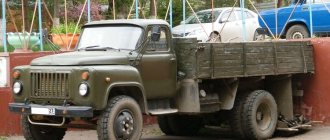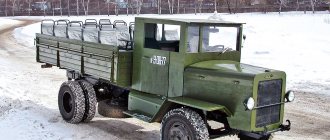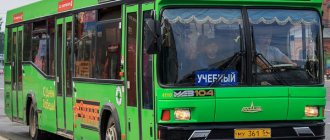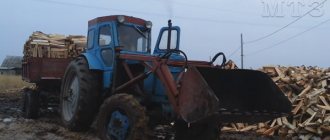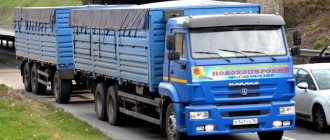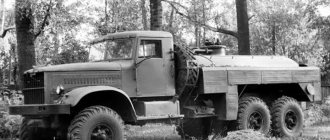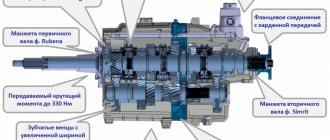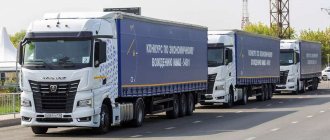| , the largest and currently only manufacturer of trucks in Finland, was founded on April 1, 1931 by engineer Tor Nessling. Its name was chosen as a result of a nationwide competition. It is translated from Finnish as “Willpower”. In 1932, the first 3-ton, 65-horsepower bonnet trucks, models “S-321” and “S-322,” were manufactured. Since 1935, the production of the most extensive “SH” series began with Finnish Olim-pia engines, and then with American Hercules engines and Swedish Volvo engines with a power of 60 ~ 95 hp . In the same year, the first 3-axle 6-ton truck "SH-3R-LF" (6x2) appeared, in 1937 - the first cabless version of the "SH-1B", a year later - the first diesel car " SHD8" with a 79 hp engine. By the end of the 30s. Sisu was one of the largest Finnish industrial enterprises, although in 1932-39. produced only 918 cars. At the height of the Second World War, a division for the production of heavy trucks and off-road timber carriers was formed, which became independent (Vanaja). After the war, Sisu moved from Helsinki to new premises in Karjaa. In 1948, it received the name “Suomen Autoteollisuus Oy” - “Finnish joint-stock automobile company”. In the 50s its program consisted of various bonneted trucks of the “K” and “L” series with a load capacity of up to 8.5 tons, respectively equipped with gasoline and diesel engines with a power of 75 ~ 165 hp. and 5-speed gearboxes. Depending on the performance, they bore their own names “Jyry-Sisu”, “Nalle-Sisu” and “Kontio-Sisu”. By the end of the 50s. the small company found itself in critical condition, stopped producing its own engines and began using English 4- and 6-cylinder diesel engines “Leyland” and “Rolls-Royce” with a power of 160 ~ 275 hp. The most powerful of them have been used since 1958 on 2-axle K36 dump trucks with a lifting capacity of 18 tons and 3-axle K34 chassis (6x2). In 1963, the KV117 (6x4) model was equipped with a tilting cab above the engine for the first time. Series of the 60s. were called “Karppä-Sisu” (Karpa-Sisu), “Maasto-Sisu” and “Ukko-Sisu”. The most famous car of the “Si-su” brand at that time was the 3.5-ton “KV45” (4x4) truck with a 135-horsepower diesel engine and an original wedge-shaped 3-seater cab above the engine. Its feature was a hydraulic pump that supplied oil under pressure to hydraulic motors installed in the wheel hubs of towed trailers. Despite the high quality and perfect design, Sisu remained on the verge of bankruptcy for a long time. She was rescued by the state, which acquired part of the shares. In 1967, Sisu returned to the fold, bringing with it the design of non-driving drawbridges. In the 70s The company began even more active cooperation with English and Swedish companies, and also began producing radial piston hydraulic pumps and hydraulic motors for use in transport and industry. By 1972-73 This includes the creation of 2- and 3-axle versions of the hood series “L” and “R” and the hoodless “M” range with a total weight of up to 26 tons with a Finnish 6.6-liter Valmet diesel engine with a power of 165 hp. or English “Ley-land” and “Rolls-Royce” with 265-335 hp, as well as 9- and 13-speed Fuller gearboxes. In 1973, one of the most famous Sisu trucks appeared - the 315-horsepower M162CST (6x2) timber carrier with a 2-axle trailer with an active front axle driven by hydraulic motors from the tractor’s hydraulic system. The total weight of the road train reached 70 tons. The new family used the same and new names: 2-axle models were offered as “Kontio-Sisu” and “Karhu-Sisu”, 3-axle models as “Yuryu-Si-su” ”, and city vans - as “Moni-Sisu”. By this time, Sisu had finally determined its development path - small-scale production of machines that were maximally adapted to work in harsh climatic and difficult road conditions, assembled from units of others, and produced only frames, cabins, suspensions and axles. Since then, most Sisu machines have been designed to work with increased loads on snowy roads, in logging sites and on rough terrain at ambient temperatures up to ~70°C. Specific Finnish standards for axle loads, weight and length of road trains make it possible to create unique multi-link vehicles with a total weight of 50~100 tons. Multi-axle trucks, dump trucks and log carriers with 8×2 or 10×2 wheel arrangements became the specificity of Sisu. The use of such super-heavy vehicles on the highway with strict adherence to permissible load standards allows additional lowering axles, the lifting of which off-road provides an increase in the adhesion weight on the drive axle and increases the vehicle's maneuverability. A feature of most Sisu cars is the steering angle increased to 48~540. The vehicles are equipped with a pre-heater, heating of all vital systems, frost-resistant rubber products and plastic parts. The machines have enhanced thermal insulation of cabins trimmed with natural wood. To work with heavy loads, especially strong and massive frames with a profile height of 300-400 mm are made of alloy steel with a thickness of 8~10 mm. Since 1970, Sisu began exporting its cars to the USSR. The first were BE-91 refrigerators on a bus chassis for transporting frozen fish in the Ocean store system. In 1981-82 "Sisu" supplied 110 logging road trains consisting of an "M162CST" tractor with a trailer to Soviet timber industry enterprises. Gradually, the USSR became the main buyer of Sisu products. By 1980, the company produced a total of 28,245 cars. In 1981, the Finnish government almost completely bought out the company's shares, significantly strengthening its financial position. At the same time, she regained her original name "Sisu". In 1981~83 A new range of “S” (“Super”) was formed, which included several families of different classes of modular design. To perform a wide range of work, the “SK” hoodless range and two similar hooded series “SL” and “SN” with wheel formulas 4×2, 6×2 and 6×4 were used. Considered the lightest in the program, they had a gross single vehicle weight of 20-33 tons and could tow 100-ton road trains. The cars were equipped with Valmet or Cummins diesel engines with a power of 170-350 hp. and multi-stage Fuller or Eaton gearboxes. The flagship "Sisu" of the 80s. became the “SM” series, which received a new tilting high-security cabin with an internal noise level of 73 dB. The “SM” range was equipped with Cummins diesel engines with turbocharging and intercooling, ZF, Fuller or Allison gearboxes, Steyr transfer cases, Spicer clutches, etc. .d. They had a wheelbase of 3400-5200 mm, a wheel arrangement from 4x2 to 10x2. At the same time, the factories in Hameenlinna and Tampere produced a range of terminal (port) tractors of the TR, TT and TV series with a 1-seat cabin for handling sea containers. The RA Raisu and SA Masi army trucks, the NA140 Nasu tracked articulated all-terrain vehicles and the XA180 Pasi wheeled armored personnel carriers were also manufactured there. At the turn of the 80-90s. has again reached a critical point. The reasons for this were increased competition, as well as perestroika in the USSR and economic reforms in the new Russia, which made regular customers insolvent. Production volume decreased from one and a half thousand to 500~550 cars per year. At this time, the company took up similar projects for work off-road and in logging sites. At the same time, the heavy hooded “SR” family, unified with the bonnetless “SM” series, came out on top. Until 1996, it included options that were distinguished by unusual technical solutions. For work in construction, quarries and on secondary roads, 23-tonne dump trucks "SR300" (8x2) with three steered and two drawbridges and "SRH332" (10x2/10x4) with four steered axles were built. including rear ones with dual-pitch wheels. The power of their Cummins engines was 370~470 hp, the total weight was 48-50 tons. For work in an underground iron ore quarry, a 5-axle tractor "SRH450CKS" (10x4) with an engine and a trailer with the full weight of the road train was created 171 tons. A 5-axle 90-ton dump truck “Supra 1000CTS (Supra) 10x8” with a 1350 hp engine was also developed. In 1996, Sisu became part of the Partek engineering group. The port tractor plant in Tampere was taken over by the Swedish company (Kalmar), and the military department was sold to the Finnish concern Patria Industries. This made it possible to launch the production of a new multi-purpose “E” family with a total weight of a single vehicle of 18-42 tons (as part of a road train - 32-60 tons). They managed to increase the share of local units to 70%. The E11M and E14M series continued to use 11- and 14-liter Cummins diesel engines (305-525 hp) and imported gearboxes with 13~18 gears. The pride of the company was the new 2-seater cabin, designed by Finnish designer Eero Miettinen, with wide horizontal ribs on the front panel. As standard, the cabin was equipped with an on-board computer, an instrument panel made of precious wood, a lacquered wooden steering wheel, and heated seats with air suspension. In 1997, it was replaced by a more modest, lighter and cheaper cab from the French Premium trucks, marking the beginning of close cooperation with (Renault), with which the joint venture Renault-Sisu Auto Oya was created Hansa Auto Oy). The new “E12” series used the American 6-cylinder diesel “Mac E7” (Mack) with a power of 430-470 hp. and a French 18-speed gearbox. At the same time, the company is producing a new family of terminal tractors with Valmet, Volvo or Cummins diesel engines with a power of 214-258 hp. and automatic transmission. By the end of the 90s. began to quickly lose independence, its inherent originality and hard-won positions. Production volume in 1997 decreased to 327 cars. In 1999, 472 cars were produced. If until recently in Finland Sisu's share accounted for 25% of the market for trucks with a gross weight of over 16 tons, then by the end of the 20th century it had decreased to 16%. However, in the country's forestry and wood processing industries, every third car still bears the Sisu brand. go to top of page |
